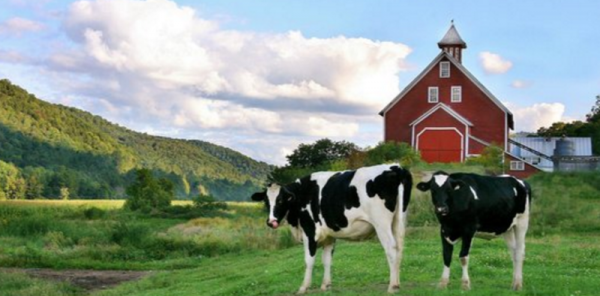
Green pasture, blue sky and red barns – they’re part of the gorgeous New England scenery, but we’ve always wondered…why are barns traditionally painted red?
Some may claim a red barn helps cows find their way home from pasture, but cows are actually colorblind to the colors red and green. So much for that answer!
We’ve tracked down a few explanations and we’ll leave it to you to choose which answer makes the most sense:
- Some might argue that older barns were not fire-engine red, but a more muted tone. That may be from the use of linseed oil that was applied to protect the wood, since it dried and hardened quickly, and lasted a long time. Farmers often mixed the oil with rust (ferrous oxide), which prevented the growth of damaging fungi and turned the mixture a dark red.
- Red barns became a fashion statement – offering a nice contrast to the traditional white farmhouse — so they grew in popularity.
- Many believe the trend started with Scandinavian farmers, who painted barns in rusty hues to emulate brick, a building material considered to be a sign of wealth.
- European settlers brought the tradition of red barns to America in the 19th century, since at that time, paints began to include chemical pigments, and red paint was the most inexpensive to buy. (When whitewash became cheaper, white barns became the rage.)
- The darker the color, the warmer the barn, since deeper hues absorb more of the sun’s rays.
We found one answer that really breaks down science:
Smithsonian Magazine reports an explanation from Google employee Yonatan Zunger:
Zunger claims that barns are painted red because red paint is cheap. Why is it cheap? Well, if you want to dig deeper, it’s because of the physics of dying stars and nuclear fusion…Say what?!
We’ll attempt to summarize:
Red ochre is a compound of iron and oxygen that absorbs yellow, green and blue light and appears red. It’s what makes red paint red and it’s really cheap because it’s plentiful due to the nuclear fusion in dying stars. Zunger explains:
The only thing holding the star up was the energy of the fusion reactions, so as power levels go down, the star starts to shrink. And as it shrinks, the pressure goes up, and the temperature goes up, until suddenly it hits a temperature where a new reaction can get started. These new reactions give it a big burst of energy, but start to form heavier elements still, and so the cycle gradually repeats, with the star reacting further and further up the periodic table, producing more and more heavy elements as it goes. Until it hits 56. At that point, the reactions simply stop producing energy at all; the star shuts down and collapses without stopping.
As soon as the star hits 56 nucleons (the total number of protons and neutrons in the nucleus), it falls apart and because the star stops at 56, it makes other substances with 56 nucleons. The element that happens to have 56 protons and neutrons in its nucleus in its stable state is iron — the stuff that makes red paint.
If you want to see Zunger’s full explanation click here.
Which answer do you agree with? Let us know in the comments below!
SOURCES:
http://home.howstuffworks.com/question635.htm
http://www.livescience.com/33195-barns-traditionally-painted-red.html

